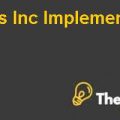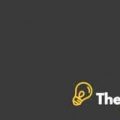Dominion Incorporation Case Study Solution
From the above Table, it could be seen that Dominion has unhealthy liquidity ratios and Leverage Ratios in except the interest coverage ratio, which implies that the company has inefficient financial strategy. The current ratio and quick ratio are less than 1, which shows that the company has not enough cash to pay its short term liabilities. Along with it, it has a negative working capital, which implies that the company has a poor liquidity position.
The debt ratio for the company is also more than 50% and the Debt-to-Equity ratios is more than 1 which shows that investment in the Dominion is riskier for the investors. Moreover, the Cash-to-Debt Ratio is far beyond the optimal levels, showing the inefficient financial management at Dominion.
The interest coverage ratio of the company is increasing which shows that the company is able to pay off its interest payments on debt. Also, the company has strong financial position in the market due to which it has good credit rating i.e. A- as shown in the Exhibit 33.8. It means that the company can easily obtain loan for further financing.
Comparison of Dominion with Industry
The above Table can be revised by adding an additional column of industry ratios in order to compare the liquidity and leverage position of Dominion with industry. Table 2 shows the comparison of Dominion ratios with industry.
Table-2: Comparison of Dominion with Industry
| Dominion Leverage and Liquidity Ratios | ||||||||
| Liquidity Ratios | Leverage Ratios | |||||||
| 2011 | 2012 | Industry 2012 | 2011 | 2012 | Industry
2012 |
|||
| Current Ratio | 0.779948 | 0.662115162 | 0.75 | Debt Ratio | 74% | 77% | 58% | |
| Quick Ratio | 0.687877 | 0.574004895 | 0.11 | Debt-to-Equity Ratio | 1.512127 | 1.585976 | 1.36 | |
| Working Capital | -1532 | -2623 | N/A | Interest Coverage Ratio | 4.081021 | 4.28125 | 5.35 | |
| Cash-to-Debt Ratio | 0.005864 | 0.014717 | N/A | |||||
It could be seen from the above table that although Dominion has inefficient liquidity position and a high leverage ratio but, its liquidity position is better than the industry. Its current ratio is quite near to the industry average. Moreover, its quick ratio is far more than the industry showing that the liquidity position of Dominion as compare to industry is quite efficient. However, the company is more risky for the investors as compare to competitors as the debt ratio and debt-to-equity ratio is more than the industry as well the interest coverage ratio is less than the industry average. (Officials, 2019)
Evaluation of Cash Flows from Cove Point
If Cove Point is accepted it would impact the cash flows of Dominion. The projected cash flows, calculated using the data given in the Exhibit 33.8, are given in the Table 3 below.
Table-3: Cove Point Projected Cash Flows
| Cove Point Cash Flow Analysis | |||||||
| Actual | Projected | ||||||
| 2012 | 2013 | 2014 | 2015 | 2016 | 2017 | ||
| Initial Investment | -3600 | ||||||
| EBIT | 3987 | 4229 | 4460 | 4683 | 5097 | ||
| NOPAT | 2592 | 2749 | 2899 | 3044 | 3313 | ||
| Add: Depreciation (Assumed 10% of CE) | 113 | 112 | 85 | 40 | 10 | ||
| Net Working Capital | 2012 | 2097 | 2180 | 2245 | 2312 | 2382 | |
| Less: Change in NWC | -85 | -83 | -65 | -67 | -70 | ||
| Less: Capital Expenditures Cove Point | -1130 | -1120 | -850 | -400 | -100 | ||
| Net cash Flows | -3600 | 1490 | 1658 | 2069 | 2617 | 3153 | |
| WACC (Assumed) | 15% | ||||||
| NPV | $2,933.14 | ||||||
| IRR | 45% | ||||||
It could be seen from the above table that the Cove point would generate substantial amount of cash flows for the company in long run. However, it would require a potential cash outflow in the short term in terms of the project cost. This implies that, Dominion which already has a poor liquidity position would further face the decline in cash. It could also lead the company to be unable to pay its debt obligations and become bankrupt, however, if the company would be able to manage its short term cash position, it would gain substantial amount of cash flows which would put a high positive impact on the liquidity position of the company. However, the project would require substantial amount of funds to be raised using debt or equity, this could result in declining bond rating for the company from A- and could result in the reduction of the share price of the company.
Recommendations
With the deep analysis of the current financial strategy of the company, it could be seen that the current liquidity and leverage position of the company is ineffective. In order to improve its liquidity and leverage position the company is recommended to change its financial strategy. It should consider the Cove Point Project, as it would generate substantial amount of cash flows for the company. However, it should select an optimal mix of debt and equity for raising funds for the project. As the debt ratio of the company is high than the optimal level, the optimal mix of debt and equity would be that in which most of the funds would be raised by using equity finance. In this way the company would be able to improve its liquidity position
Conclusion
Although, the company has an ineffective liquidity and leverage position due to the ineffective financial strategy, but, this position could be improved by accepting the Cove Point Project using an optimal debt and equity mix. As the project would bring substantial amount of positive cash flows in long run, the liquidity position would be improvised ultimately.............
This is just a sample partical work. Please place the order on the website to get your own originally done case solution.









